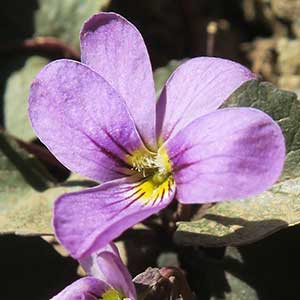Viola flettii
Viola quercetorum
Flett's violet, Olympic violet, rock violet
goosefoot violet, goosefoot yellow violet, oakwoods violet
1–3, ascending to erect, mostly glabrous, on caudex from fleshy rhizome.
1–5, spreading to erect, leafy proximally and distally, usually elongated by end of season, puberulent to canescent, on caudex from subligneous rhizome.
basal and cauline;
basal: 1–3;
stipules linear-lanceolate, margins entire or with glandular processes, apex acuminate;
petiole 1.5–9.7 cm, mostly glabrous;
blade purple-tinted and –veined, broadly reniform to ovate, 0.9–2.4 × 1.2–4 cm, base cordate, margins finely crenate-serrate, eciliate, apex acute to obtuse, surfaces glabrous or sparsely pubescent along veins adaxially;
cauline similar to basal except: stipules ovate to lanceolate, margins entire or shallowly laciniate;
petiole 0.7–5.9 cm, usually glabrous;
blade 0.8–2.1 × 1.2–3.1 cm.
basal and cauline;
basal: 1–6;
stipules adnate to petiole, forming 2 linear, membranous wings, each wing with lanceolate to ± deltate projection, margins entire or laciniate, apex usually long-acuminate or divided into narrow, filiform processes;
petiole 1.9–9.5 cm, puberulent;
blade usually grayish green to whitish, sometimes ± purple-tinted abaxially, green to grayish green adaxially, ± ovate to ± orbiculate, deltate, pandurate, or broadly brownish purple abaxially, lower 3 dark brown-veined, lateral 2 sparsely to densely bearded, lowest 10–16 mm, spur yellow to reddish brown, gibbous, 1–2 mm;
style head bearded; cleistogamous flowers axillary.
1.8–7.1 cm, usually glabrous.
sepals lanceolate, margins eciliate, auricles 0.5–1.5 mm;
petals soft reddish violet on both surfaces, all with yellow area basally, lower 3 dark violet-veined, lateral 2 bearded, lowest with white around yellow area, 10–15 mm, spur yellow, gibbous, 0.5–2 mm;
style head bearded; cleistogamous flowers axillary.
± spherical, 5–9 mm, glabrous.
ovoid to ellipsoid, 8–12 mm, puberulent.
dark brown to brownish purple, 2.5–3 mm.
medium brown, ± 2.7 mm.
= 24.
Viola flettii
Viola quercetorum
Viola flettii is endemic to the Olympic Mountains of northwestern Washington. C. S. McCreary (2005) noted that although morphologically and ecologically distinct, V. cuneata, V. flettii, and V. ocellata are closely related.
(Discussion copyrighted by Flora of North America; reprinted with permission.)
Herbarium specimens of Viola quercetorum and V. purpurea var. purpurea can be difficult to distinguish; pressing obliterates the undulate leaf margins of V. quercetorum. In Oregon, most collections of V. quercetorum are from yellow pine forests (A. Liston, pers. comm.).
Viola quercetorum hybridizes with V. douglasii (J. Clausen 1964).
(Discussion copyrighted by Flora of North America; reprinted with permission.)


